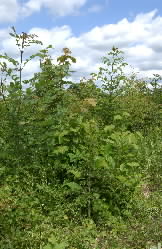 This section contains general background information about biomass and woodfuel.
This section contains general background information about biomass and woodfuel.
When we talk about biomass for energy, what exactly are we talking about?
What is the point of using biomass for energy, rather than other fuels and energy sources? And how can we be sure we do it in a way that is sustainable and actually gives saving in greenhouse gases compared to the alternatives?
Biomass is biological material derived from living, or recently living organisms. In the context of biomass for energy this is often used to mean plant based material, but biomass can equally apply to both animal and vegetable derived material.
Biomass is carbon-based and is composed of a mixture of organic molecules containing hydrogen, usually including atoms of oxygen, often nitrogen and also small quantities of other atoms, including alkali, alkaline earth and heavy metals. These metals are often found in functional molecules such as the porphyrins which include chlorophyll which contains magnesium.
The carbon used to construct biomass is absorbed from the atmosphere as carbon dioxide (CO2) by plant life, using energy from the sun.
Plants may subsequently be eaten by animals and thus converted into animal biomass. However the primary absorption is performed by plants.
If plant material is not eaten it is generally either broken down by micro-organisms or burned:
These processes have happened for as long as there have been plants on Earth and is part of what is known as the carbon cycle.
Fossil fuels such as coal, oil and gas are also derived from biological material, however material that absorbed CO2 from the atmosphere many millions of years ago.
As fuels they offer high energy density, but making use of that energy involves burning the fuel, with the oxidation of the carbon to carbon dioxide and the hydrogen to water (vapour). Unless they are captured and stored, these combustion products are usually released to the atmosphere, returning carbon sequestered millions of years ago and thus contributing to increased atmospheric concentrations.
The vital difference between biomass and fossil fuels is one of time scale.
Biomass takes carbon out of the atmosphere while it is growing, and returns it as it is burned. If it is managed on a sustainable basis, biomass is harvested as part of a constantly replenished crop. This is either during woodland or arboricultural management or coppicing or as part of a continuous programme of replanting with the new growth taking up CO2 from the atmosphere at the same time as it is released by combustion of the previous harvest.
This maintains a closed carbon cycle with no net increase in atmospheric CO2 levels.
Within this definition, biomass for energy can include a wide range of materials.
The realities of the economics mean that high value material for which there is an alternative market, such as good quality, large timber, are very unlikely to become available for energy applications. However there are huge resources of residues, co-products and waste that exist in the UK which could potentially become available, in quantity, at relatively low cost, or even negative cost where there is currently a requirement to pay for disposal.
There are five basic categories of material:
Biomass is a renewable, low carbon fuel that is already widely available throughout the UK. Its production and use also brings additional environmental and social benefits. Correctly managed, biomass is a sustainable fuel that can deliver a significant reduction in net carbon emissions when compared with fossil fuels.
Correctly managed, biomass is a sustainable fuel that can offer a wide range of benefits: